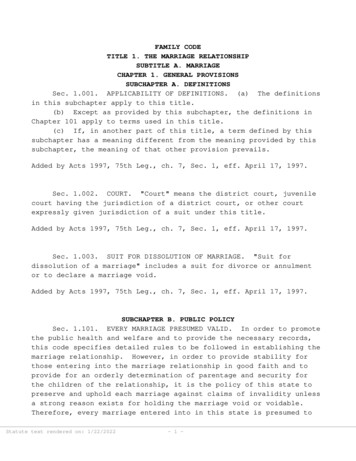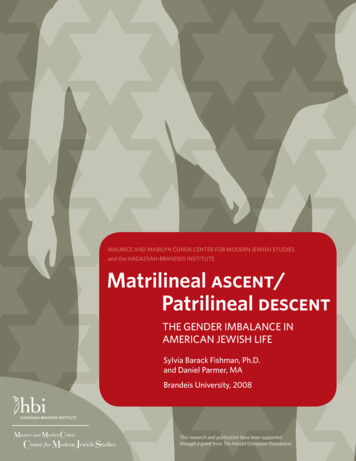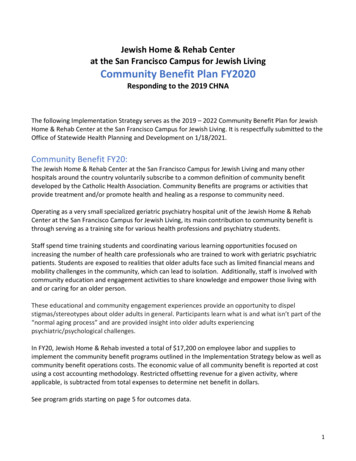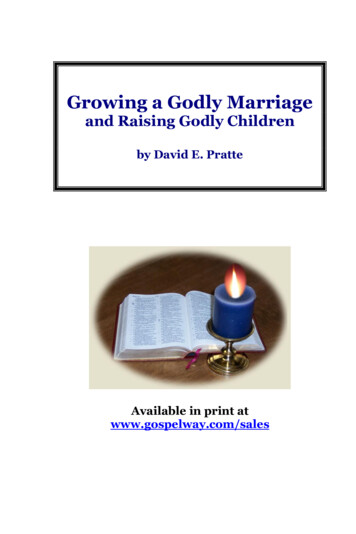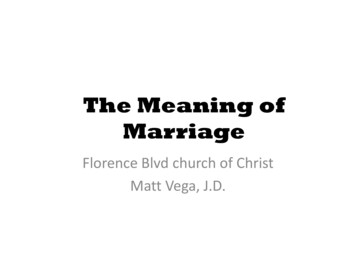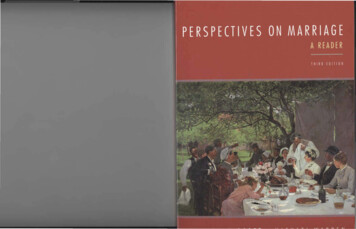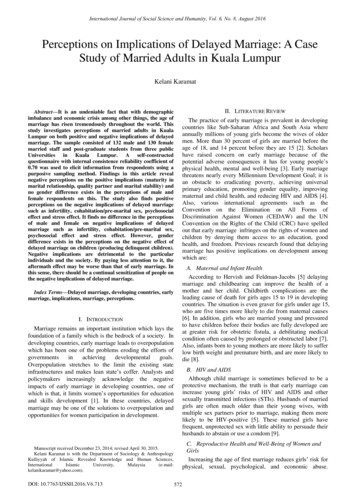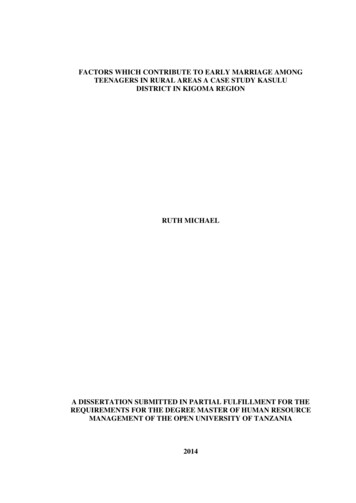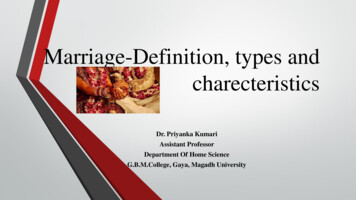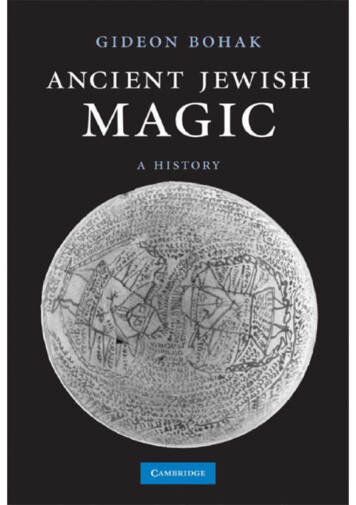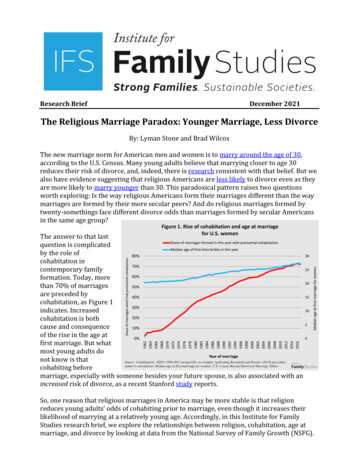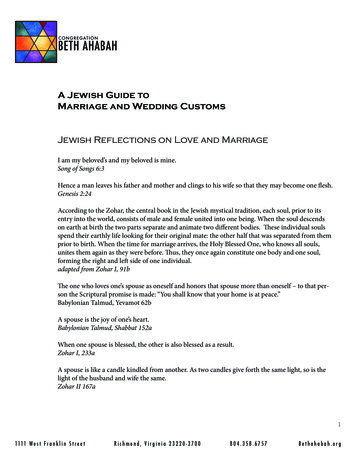
Transcription
A Jewish Guide toMarriage and Wedding CustomsJewish Reflections on Love and MarriageI am my beloved’s and my beloved is mine.Song of Songs 6:3Hence a man leaves his father and mother and clings to his wife so that they may become one flesh.Genesis 2:24According to the Zohar, the central book in the Jewish mystical tradition, each soul, prior to itsentry into the world, consists of male and female united into one being. When the soul descendson earth at birth the two parts separate and animate two different bodies. These individual soulsspend their earthly life looking for their original mate: the other half that was separated from themprior to birth. When the time for marriage arrives, the Holy Blessed One, who knows all souls,unites them again as they were before. Thus, they once again constitute one body and one soul,forming the right and left side of one individual.adapted from Zohar I, 91bThe one who loves one’s spouse as oneself and honors that spouse more than oneself – to that person the Scriptural promise is made: “You shall know that your home is at peace.”Babylonian Talmud, Yevamot 62bA spouse is the joy of one’s heart.Babylonian Talmud, Shabbat 152aWhen one spouse is blessed, the other is also blessed as a result.Zohar I, 233aA spouse is like a candle kindled from another. As two candles give forth the same light, so is thelight of the husband and wife the same.Zohar II 167a11111 W e s t F r a n k l i n S t r e e tRichmond, Virginia 23220-3700804.358.6757Bethahabah.org
From every human being there rises a light that reaches straight to heaven. And when two soulsthat are destined to be together find each other, a single brighter light goes from their united being.Baal Shem TovWhen husband and wife are worthy, God’s Presence abides with them.Babylonian Talmud, Sotah 17aA man who does not have a wife lives without joy, without blessing, and without goodness.Babylonian Talmud, tractate Yevamot, 62bWhere there is no union of male and female, men are not worthy of beholding the Shekhinah[Divine Presence of God].Zohar, volume 3, portion Aharei Mot, page 59aI will betroth you with righteousness, with justice, with love and compassion. I will betroth youwith faithfulness and you will know God.Hosea, 2:19 – 20Set me as a seal upon your heart, as a seal upon your arm,for love is as strong as death .Many waters cannot quench love, nor can floods drown it.Song of Songs 8:6 – 7My soul takes pleasure in three things, for they are beautiful to God and to all: harmony amongpeople, friendship among neighbors, and a husband and wife suited to each other.Ben Sira 25:1God creates new worlds constantly by causing marriages to take place.Zohar 1:89a21111 W e s t F r a n k l i n S t r e e tRichmond, Virginia 23220-3700804.358.6757Bethahabah.org
IntroductionIn Jewish life, marriage is considered the ideal state between two people. It is the expression of theprofound love which two people have for one another and the basis of family life. This relationshipis so unique that Judaism calls it Kiddushin, “holiness.” It is one of the ways which people bringsanctity into their lives and transform their relationship into a sacred bond which links it to God.The ancient Jews believed that the Temple in Jerusalem, the mikdash, was God’s dwelling placeon earth. After the Temple was destroyed and to reflect the sanctity and importance of marriage,Jewish tradition referred to the home of a loving couple and their family as a Mikdash M’at, a “smallsanctuary,” a place where God dwells.Marriage is also a mitzvah, a commandment. In that sense, marriage is a Jewish act, a commitmentto the continuity and vitality of the Jewish community.This booklet is designed to explain the traditional and contemporary meanings of many customsand rituals that surround marriage and the wedding ceremony. It also covers many of the details inplanning a wedding at Beth Ahabah.31111 W e s t F r a n k l i n S t r e e tRichmond, Virginia 23220-3700804.358.6757Bethahabah.org
Planning Your WeddingSetting a Date and TimeBefore finalizing a wedding date and time for the ceremony, the couple should check with the Rabbito ensure his availability.Any day of the week except Shabbat and Jewish Holy Days is suitable for a Jewish wedding. Intraditional Judaism, there are certain additional days during the year on which weddings do nottake place, but at Beth Ahabah weddings may take place on those days.The time of the ceremony can be affected by many factors. On Saturday nights and after Holy Days,weddings must be scheduled after dinner time.LocationThe couple should choose a location that is respectful to hold a religious service. To arrange awedding in the synagogue, please contact the Rabbi.Many details and logistics for weddings are handled by the Temple’s Executive Director, who willgladly help with the numerous questions which arise when planning a wedding.The Temple is also available for wedding receptions. Please contact our Executive Director forinformation about fees and rules for the use of the facilities.Weddings are also held in other settings, like gardens, hotels and restaurants. Before finalizing alocation outside of the synagogue, the couple should check with the Rabbi to be sure he is able totravel to the location.OfficiantsIt is customary for the Rabbi of the congregation where the wedding is held to officiate at thewedding ceremony. At Beth Ahabah, this custom is a matter of policy. If the bride and groomwould like a Rabbi or Cantor who is not affiliated with the congregation to co-officiate, the hostRabbi will help make those arrangements.Premarital Meetings and CounselingProspective brides and grooms meet with the Rabbi several times before the wedding to discussnot only the ceremony but also aspects of their relationship with and expectations for one another.These sessions enable the couple and Rabbi to get to know each other better and make the weddingmore personal and intimate.41111 W e s t F r a n k l i n S t r e e tRichmond, Virginia 23220-3700804.358.6757Bethahabah.org
Couples are encouraged to meet with the Executive Director to go over logistical detailssurrounding the wedding, the rules concerning use of the Temple’s facilities, and the guidelines forvendors involved with the wedding.Wedding RehearsalsThe couple and Rabbi discuss privately many of the details surrounding the ceremony itself. Inaddition, most families arrange a rehearsal to practice the processional, recessional and theplacement of people on the Bimah. The rehearsal is usually conducted by a wedding consultant,photographer or florist. The Rabbi does not attend the rehearsal. Rehearsals must be scheduledwith the Executive Director. If held on a Friday, rehearsals must be finished by 6:00 p.m.Music for the CeremonySince the wedding is a religious ceremony, the music should reflect the dignity and sanctity of theoccasion. In selecting music the couple should consult with the Music Director who can offer themmany suggestions and much guidance.Most couples engage the Temple’s Music Director to play at the ceremony, but some use a varietyof other musicians. Especially in the latter case, it is important to discuss the music with the MusicDirector because most musicians are unfamiliar with music used at Jewish weddings.Photography and VideographyMost couples desire a tangible memory of the ceremony in the form of photographs or video.Desiring to balance this wish with the dignity of the religious nature of the ceremony, we expectcouples and vendors to follow our policies and procedures.Photography may be taken on the floor of the sanctuary up to 45 minutes before the start of theceremony or after its conclusion, with one exception. The photographer may stand in the aisle ofthe sanctuary at the back row to photograph the processional and recessional.The Rabbi will be available for pictures 45 minutes before the beginning of the ceremony.During the ceremony, photography is permitted from the back balcony but only with availablelight. No still photography is permitted from the floor of the sanctuary during the ceremony(except as described above). At weddings outside the sanctuary, we ask the photographer to remainstationary and behind the congregation during the ceremony.The ceremony may be video recorded from the balcony or rear of the sanctuary using one or morestationary cameras on tripods. No auxiliary lighting is permitted during the ceremony and camerasmay not be placed on the Bimah or in the sanctuary aisles.Please discuss these rules with the photographer and videographer.51111 W e s t F r a n k l i n S t r e e tRichmond, Virginia 23220-3700804.358.6757Bethahabah.org
Wedding receptionsThe Temple is an attractive and convenient location for wedding receptions following theceremony. Please contact our Executive Director for more information.HonorariaThe services of the Rabbi are free to congregational members for all lifecycle events, includingweddings. Contributions to a Temple fund in appreciation for their officiation are appropriate butare completely at the discretion of the family.Non-members are welcome to contact the Associate Rabbi, and based upon his availability, he mayofficiate.The KetubahThe ketubah, or Jewish wedding certificate, is signed before the wedding. Many couples supply aketubah they have purchased or has been given to them as a gift. Most companies that sell ketubotalso insert all of the necessary information. While there is usually a charge for this, we encouragecouples to take advantage of this service because the writing will be done in calligraphy and matchthe rest of the ketubah.The Temple is happy to provide a ketubah, and the Rabbi can show it to the couple during one oftheir premarital meetings.Two witnesses are required to sign the ketubah, and it is customary that they be Jewish andunrelated to the bride and groom.The State LicenseEvery couple must obtain a license in order to be married in Virginia. Licenses are issued atevery Circuit Court Clerk’s office in Virginia and may be used anywhere in the state. The bride andgroom must appear in person and pay in cash. A photo ID and Social Security number are requiredto obtain a license. There is no waiting period for a license and it is valid for 60 days. Since requirements for the license may change from time to time, the couple should call the Circuit CourtClerk’s office beforehand to verify them.The couple must bring the license to the location of the ceremony on the day of thewedding. The Rabbi fills out and signs the license at the same time the ketubah is signed.61111 W e s t F r a n k l i n S t r e e tRichmond, Virginia 23220-3700804.358.6757Bethahabah.org
AufrufIt is traditional for the bride and groom to receive a blessing at Shabbat services before thewedding. Often the couple is also given the honor of an aliyah (reciting the Torah blessings) at theservice. Whether done in a traditional or more contemporary manner, this ceremony is called anaufruf.On the Day of the CeremonyJudaism supports the idea that the couple can and should see each other before the ceremony. Assuch, we encourage families to take photographs before the wedding so they can enjoy thefestivities following the ceremony.The signing of the ketubah and the state marriage license takes place 45 minutes before the startof the ceremony. Family members, the bridal party and the photographer are often present for thesigning.After the signing of the ketubah, the Rabbi spends a few minutes alone with the couple and theirparents to set the proper tone for the ceremony that follows. The couple often does the bedecken,or veiling ceremony at this point.Couples are both very busy and somewhat nervous on the day of the ceremony so they should eatsomething prior to the wedding. In addition, it is essential that everybody involved in the weddingrefrain from alcoholic beverages prior to the ceremony.71111 W e s t F r a n k l i n S t r e e tRichmond, Virginia 23220-3700804.358.6757Bethahabah.org
Wedding CustomsThe modern Jewish wedding consists of elements from many sources and times in history. Theorigin of most customs is ancient, dating from the Rabbinic period (c. 100 BCE – c. 900 CE). Themeanings of Jewish customs have evolved continually over time.The ChupahThe chupah is the wedding canopy under which couples are married. It symbolizes the home theyare about to create. When most weddings occurred outside, the chupah also served to protect thecouple from the elements. Even though most weddings now take place inside, it is customary forthe ceremony to take place “under the chupah.”A chupah usually consists of cloth attached to either freestanding or handheld poles. The earliestversion of the chupah was probably a tallit, or prayer shawl, held over the couple by four attendants.This tradition is still sometimes practiced today though the tallit is now usually attached to poles. Achupah can also be made from flowers.For ceremonies at Beth Ahabah, couples may use the Temple’s chupah or arrange for one of theirown. Since the Temple’s chupah is large and stationary, it can only be used in the sanctuary and notat another location.The ProcessionalIn Judaism, it is a mitzvah to accompany the bride and groom to the chupah. Older relatives oftenlead the processional and sit for the ceremony. Usually the groom, his attendants, if any, the bestman and the groom’s parents precede the bride, her attendants, if any, the maid-of-honor and thebride’s parents in the processional. Often the bride and groom are accompanied by their parentswho stand under the chupah during the ceremony.The Rabbi generally walks to the chupah from the side and before the processional starts. At BethAhabah, he enters from the door on the Bimah.Insurance regulations prohibit the use of candles during the processional and wedding.The KetubahTraditionally, a Jewish marriage had legal standing enforced by the Jewish community, and theketubah was a written document that established the terms of the agreement. It protected the rightsof the bride, stipulated the terms of divorce, and listed the groom’s obligations to the bride. It was,and still is, signed by two witnesses, Jewish and unrelated to the couple, before the ceremony.81111 W e s t F r a n k l i n S t r e e tRichmond, Virginia 23220-3700804.358.6757Bethahabah.org
In modern times, now that the legal side of marriage is the province of civil authorities, the ketubahtakes on more of a religious and spiritual quality. In non-Orthodox settings, the text of the ketubahhas been changed to reflect this newer spiritual emphasis and the mutuality of the commitmentmade by the bride and groom toward each other and their marriage.Today there are many versions of the text of the ketubah, and they are available from manysources. When selecting a ketubah, couples should consider the actual words of the text in additionto artistic quality of the document.CirclingsTraditionally, when the bride and groom reached the chupah, the bride would circle the groomseven times before the start of the ceremony. This symbolized the love with which the bride“encircled” the groom and the protective quality of their home over which the bride presided.Today, when more and more Jews want to recapture traditional elements of Jewish life, somecouples observe this custom by circling one another, thus affirming the Reform Jewish value ofgender equality.The RingIn Rabbinic times, when a marriage was a legal and business transaction between families, thegroom gave the bride a ring the value of which was agreed upon and could be objectivelyconfirmed. Thus, the ring was solid, usually made of a precious metal, and without stones orcarvings because their value was subjective.Couples married at Beth Ahabah may use any rings that suit their taste. Almost every coupleincorporates a double ring ceremony into the wedding in keeping with Reform Jewish values aboutthe equality of men and women in Jewish life.Breaking the GlassJewish weddings end when the groom steps on and breaks a glass wrapped in a cloth. Everyoneassembled responds by shouting mazel tov, which means “good luck.”While the act and the response seem to be joyous, this custom actually has several interpretations,all of which are quite serious. One is to remember the destruction of the Temple in Jerusalem, asad event in Jewish history. Another is to remind us that both joy and sorrow go hand-in-hand. Yetanother is a warning about the fragility of life and how easily our plans, hopes and dreams can beshattered. Finally, it links us to the world around us. We pray that others who are not as fortunate aswe are may one day experience the joy we feel on our wedding day, and, hopefully, throughout themarried life ahead of us.91111 W e s t F r a n k l i n S t r e e tRichmond, Virginia 23220-3700804.358.6757Bethahabah.org
The Wedding CeremonyToday’s Jewish wedding ceremony is a series of parts leading up to and then away from the ringceremony. How the parts fit together, and sometimes even their order, is determined as muchby the practice of the individual Rabbi as it is by tradition. The result is a beautifully constructedwhole which is meaningful, personal and spiritually dramatic. Only the educated eye can discernthe seams.BedeckenInspired by the Biblical account of the mistaken marriage between Jacob and Leah, the sister ofJacob’s beloved Rachel, the bride and groom in Jewish weddings are expected to see one anotherbefore the wedding. The bedecken provides a religious context for that to occur. Traditionally, thegroom was escorted to the bride who was surrounded by her family and friends. He then loweredher veil over her face (bedecken means veiling). Today, when few brides wear veils, the bedeckensets the tone for the ceremony to follow and, in that sense, can be understood as the figurative startof a Jewish wedding.Welcoming the CoupleThe actual and formal wedding ceremony begins once the couple has reached the chupah. They aregreeted with words of welcome taken from Psalm 118 and a medieval liturgical poem.ErusinIn Rabbinic times, a wedding had two very distinct sections, each with its own ceremony andseparated from one another by a year. The bride continued to live with her parents during thisinterval.The first ceremony was called erusin, or betrothal; the second ceremony was called nissuin, ormarriage. The word kiddushin was also used for the betrothal ceremony and eventually it becamethe name for the wedding.In today’s combined ceremony, the traditional or a modified version of erusin is recited over a cupof wine. The blessing thanks God for marriage and expresses our gratitude that the couple isentering into marriage.VowsJewish tradition does not require the couple to make any public vows during the ceremony.Couples may choose to recite vows if they wish.101111 W e s t F r a n k l i n S t r e e tRichmond, Virginia 23220-3700804.358.6757Bethahabah.org
Ring CeremonyThe ring ceremony is the central part of a Jewish wedding. Traditionally there was only one ring,and it was placed by the groom on the index finger of the bride. He then recited a short but cleardeclaration of marriage. If the bride accepted the ring and her acceptance and the groom’sdeclaration were properly witnessed, the couple was married.Today most couples exchange rings and both make the traditional declaration to the other inlanguage which differs only by Hebrew’s grammatical requirements. Usually the bride’s ring isplaced on the ring (fourth) finger of her left hand but couples may use the traditional index fingerof her right hand if they wish.Reading the KetubahIn some weddings, the Rabbi reads part or all of the ketubah during the ceremony. Traditionally,this marked the separation between the original two sections of the wedding.Sheva BerachotOnce the bride and groom have expressed their intention to be married and exchanged their rings,the Rabbi then asks God’s blessing upon the couple in the form of seven blessings. One is theblessing over the wine. In some weddings the couple shares another cup of wine, while in others theblessing is included as part of the seven without drinking a second time.Pronouncement and BlessingOften, because of state requirements or longstanding custom, the Rabbi pronounces the couplehusband and wife. The formal ceremony then concludes with the Rabbi asking God to bless thecouple with words from the Torah which are known as the “priestly benediction.”In most Jewish weddings the groom then steps on and breaks a glass.YichudTraditionally, the bride and groom share a short period alone together, called yichud, following theceremony. It allows them to gather their thoughts and prepare for the reception. If the couple hasfasted on the day of the wedding, they break their fast during yichud.111111 W e s t F r a n k l i n S t r e e tRichmond, Virginia 23220-3700804.358.6757Bethahabah.org
IntermarriageWe recognize that many couples grapple with coming from different faiths. Jewish law prohibitsintermarriages, or to be more precise, does not recognize intermarriages as valid Jewish marriages.Until the 1960s, intermarriage — marriage between a Jew and a non-Jew — was rare. By the 1980s,almost half of all Jews married someone not born Jewish. Today within Reform Judaism, there isongoing discussion about the impact of intermarriage and how the movement should best supportour families while also preserving our traditions.Today, many Reform Rabbis officiate at marriages where the couple is building a Jewish identityas a family. Couples contemplating an intermarriage should consult with the Rabbi to discuss theissues facing them as well as the Rabbi’s position regarding officiation.Same-Sex WeddingsBeth Ahabah welcomes same-sex couples who are committed to building a Jewish family. Marriageis about the commitment of love and respect; we support and affirm the love that LGBTQ peopleshare and the families they build.Other Special SituationsIllness in the FamilyA serious illness of someone close to the bride or groom may cause the couple to reassess theirplans for the wedding and the social activities around it. While it is praiseworthy to take the healthof an ill relative into account, it is usually not necessary to cancel or radically change the plans forthe wedding. Consult with the Rabbi to decide how to proceed.Death in the FamilyThe death of a close relative can be a traumatic, upsetting event. When someone in the immediatefamily of the bride or groom dies, Jewish tradition prohibits a wedding for 30 days. As one wouldexpect, the festivities surrounding the wedding are also more subdued than originally planned.Reform Judaism is flexible in this matter and encourages the bride and groom to consult with theRabbi to determine how to proceed.121111 W e s t F r a n k l i n S t r e e tRichmond, Virginia 23220-3700804.358.6757Bethahabah.org
GlossaryAliyah – “Having an aliyah” means having the honor of being called to the Torah to recite theblessings before and after its reading during worship services. Literally, the Hebrew word means“going up.” Pronounced a-lee-ya.Aufruf – the name of the ceremony for honoring a bride and groom at a Shabbat service beforetheir wedding. It usually includes a blessing of the couple from the Rabbi and often an aliyah. Theword comes from Yiddish. Pronounced uf-ruf.Bedecken – the ceremony before the wedding during which the groom places the bride’s veilover her face. It exists today with many contemporary variations. The word comes from Yiddish.Pronounced bi-dek-in.Bimah – the synagogue’s pulpit. The word is Hebrew and literally means “high place.”Pronounced be-ma.Chupah – Hebrew for the wedding canopy. Pronounced chu-paErusin – the Hebrew term for the central blessing in what was originally the separate, first partof the wedding and now incorporated in today’s ceremony. It means “betrothal.” Pronounceday-ru-seen.Ketubah – the Hebrew name of the Jewish document which certifies the wedding. It comesfrom the Hebrew root meaning “to write.” Pronounced ki-tu-ba.Kiddushin – the Hebrew word now often used to refer to the wedding in general but technicallyanother word for erusin. It comes from the Hebrew root meaning “holiness.”Pronounced ki-du-sheen.Mazel Tov – the Hebrew expression meaning “good luck” or “congratulations” and often shouted by the guests at the end of the wedding after the groom breaks the glass.Pronounced ma-zel-tof.Mikdash – the Hebrew term for the ancient Temple in Jerusalem. It literally means “sanctuary.”Pronounced meek-dahsh.Mikdash M’at – a Jewish term which refers to a Jewish home and which literally means inHebrew “a small sanctuary.” Meek-dahsh mi-ahtMitzvah – Hebrew for “commandment,” referring to a law from the Torah. Pronounced mitz-va.131111 W e s t F r a n k l i n S t r e e tRichmond, Virginia 23220-3700804.358.6757Bethahabah.org
Nissuin – the Hebrew name of what was originally the separate, second part of the wedding butnow the latter part of the combined ceremony. The central part of nissuin is the reciting of thesheva berachot. Pronounced ni-sue-een.Sheva Berachot – seven blessings, often chanted by a Cantor, which serve as the centerpieceof nissuin. Pronounced shevva bi-ra-choteTallit – a prayer shawl, sometimes worn by the groom at a wedding and sometimes used as achupah. Pronounced ta-leet.Yichud – the brief period after the wedding when the bride and groom spend a few minutesalone. The word comes from the Hebrew meaning “unity.” Pronounced yee-chood.141111 W e s t F r a n k l i n S t r e e tRichmond, Virginia 23220-3700804.358.6757Bethahabah.org
Marriage is also a mitzvah, a commandment. In that sense, marriage is a Jewish act, a commitment to the continuity and vitality of the Jewish community. This booklet is designed to explain the traditional and contemporary meanings of many customs and rituals that surround marriage and the wedding ceremony. It also covers many of the details in
